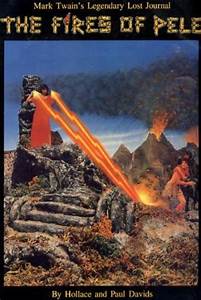 By HOLLACE DAVIDS, PAUL DAVIDS, SERGIO ARAGONES (Pictorial Legends; 1986)
By HOLLACE DAVIDS, PAUL DAVIDS, SERGIO ARAGONES (Pictorial Legends; 1986)
The first and it seems only release from Pictorial Legends, a short-lived publishing outfit set up by Marvel animator Paul Davids (of the old TRANSFORMERS cartoon series).
A graphic novel of sorts, THE FIRES OF PELE purports to be a lost journal kept by a young Mark Twain during his 1866 sojourn in Hawaii, a.k.a. the “Sandwich Islands,” where he confronted all manner of odd creatures. The diary entries, related in an authentically Twain-ish voice, are accompanied by elaborate photographic illustrations that incorporate painting and cartoon figures (by MAD’S Sergio Aragones) in a manner that was apparently quite revolutionary back in 1986. Hence, this volume is charmingly nostalgic on two fronts, harkening back to the days when Hawaii was viewed as a mysterious and forbidding environ as well as those of pre-Photoshop image manipulation.
The Sandwich Islands of this book are populated by a race of tiny people called Menehulas, as well as the demon goddess Pele and the steam god Moho, who has an smoking mini-volcano atop his head. Mark Twain enters the picture as a guest of one Prince Lakekua, who Pele loves. When the prince spurns Pele’s advances she kidnaps the prince’s bride-to-be with the help of some eel henchmen, who haul the gal off in a giant clam shell and imprison her in a volcano dungeon. It’s up to Twain and the price to rescue the princess, but they’ll have to get by Kona, the ugly monster who guards Pele’s domain. In the process the prince is turned into a statue and Twain is shrunk down to be transported by a seagull, only to meet a new menace in the form of demon owls…
Adding to the uniqueness of the tale, which also includes a talking fish, giant scorpion and floating island, is the bemused and unruffled tone in which the whole thing is related. The full page illustrations add a certain magic of their own, even though they’re downright primitive by modern standards (the monsters pictured never look like anything more than the clay models and/or paintings they are).
On the downside, the whole thing suffers from the sort of vile cutesiness that afflicted many eighties-era graphic novels prior to THE DARK KNIGHT RETURNS and WATCHMEN (both of which incidentally appeared the same year as this book), and is evident here in the sweet and cuddly Aragones drawn Menehulas (whose every appearance seems calibrated to make us say “Aaaaaaaaaw!”). Such mawkish horseshit often passed for kid-friendly entertainment in the eighties, but speaking as one who was a kid back then I can assure you that was a miscalculation, one that detracts mightily from this otherwise striking and imaginative account.
